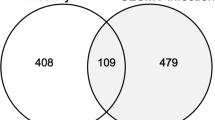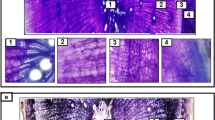Abstract
Tuberization in cassava (Manihot esculenta Crantz) occurs simultaneously with plant development, suggesting competition of photoassimilate partitioning between the shoot and the root organs. In potato, which is the most widely studied tuber crop, there is ample evidence suggesting that metabolism and regulatory processes in leaf may have an impact on tuber formation. To search for leaf proteins putatively involved in regulating tuber generation and/or development in cassava, comparative proteomic approaches have been applied to monitor differentially expressed leaf proteins during root transition from fibrous to tuberous. Stringent cross comparison and statistical analysis between two groups with different plant ages using Student’s t test with 95% significance level revealed a number of protein spots whose abundance were significantly altered (P < 0.05) during week 4 to week 8 of growth. Of these, 39 spots were successfully identified by ion trap LC–MS/MS. The proteins span various functional categories from antioxidant and defense, carbohydrate metabolism, cyanogenesis, energy metabolism, miscellaneous and unknown proteins. Results suggested possible metabolic switches in the leaf that may trigger/regulate storage root initiation and growth. This study provides a basis for further functional characterization of differentially expressed leaf proteins, which can help understand how biochemical processes in cassava leaves may be involved in storage root development.



Similar content being viewed by others
Abbreviations
- 2-DE:
-
2-Dimensional gel electrophoresis
- CBB:
-
Coomassie brilliant blue
- LC–MS/MS:
-
Liquid chromatography coupled with tandem mass spectrometry
References
Bachem CWB, van der Hoeven RS, de Bruijn SM, Vreugdenhil D, Zabeau M, Visser RGF (1996) Visualization of differential gene expression using a novel method of RNA fingerprinting based on AFLP: analysis of gene expression during potato tuber development. Plant J 9:745–753
Baier M, Dietz K-J (1997) The plant 2-Cys peroxiredoxin BAS1 is a nuclear-encoded chloroplast protein: its expressional regulation, phylogenetic origin, and implications for its specific physiological function in plants. Plant J 12:179–190
Baier M, Dietz K-J (1999) Protective function of chloroplast 2-Cysteine peroxiredoxin in photosynthesis: evidence from transgenic Arabidopsis. Plant Physiol 119:1407–1414
Brandes HK, Larimer FW, Hartman FC (1996) The molecular pathway for the regulation of phosphoribulokinase by thioredoxin f. J Biol Chem 271:3333–3335
Cabral GB, Carvalho LJCB (2001) Analysis of proteins associated with storage root formation in cassava using two-dimensional gel electrophoresis. Rev Bras Fisiol Veg 13:41–48
Dietz KJ (2007) The dual function of plant peroxiredoxins in antioxidant defence and redox signaling. Subcell Biochem 44:267–294
Dugaiczyk A, Haron JA, Stone EM, Dennison OE, Rothblum KN, Schwartz RJ (1983) Cloning and sequencing of a deoxyribonucleic acid copy of glyceraldehyde-3-phosphate dehydrogenase messenger ribonucleic acid isolated from chicken muscle. Biochemistry 22:1605–1612
El-Sharkawy MA (2004) Cassava biology and physiology. Plant Mol Biol 56:481–501
Ewing EE, Struik PC (1992) Tuber formation in potato: induction, initiation, and growth. In: Janik J (ed) Horticultural Reviews. John Wiley & Sons, New York, pp 89–198
Gibson JL, Chen JH, Tower PA, Tabita FR (1990) The form II fructose 1, 6-bisphosphatase and phosphoribulokinase genes form part of a large operon in Rhodobacter sphaeroides: primary structure and insertional mutagenesis analysis. Biochemistry 29:8085–8093
Gregory LE (1956) Some factors for the tuberization in the potato plant. Am J Bot 43:281–288
Hannapel DJ (1991) Characterization of early events of potato tuber development. Physiol Plant 83:568–573
Huang XY, Barrios LA, Vonkhorporn P, Honda S, Albertson DG, Hecht RM (1989) Genomic organization of the glyceraldehyde-3-phosphate dehydrogenase gene family of Caenorhabditis elegans. J Mol Biol 206:411–424
Jackson SD, James P, Prat S, Thomas B (1998) Phytochrome B affects the levels of a graft-transmissible signal involved in tuberization. Plant Physiol 117:29–32
Jørgensen K, Bak S, Busk PS, Sørensen C, Olsen CE, Puonti-Kaerlas J, Møller BL (2005) Cassava plants with a depleted cyanogenic glucoside content in leaves and tubers. Distribution of cyanogenic glucosides, their site of synthesis and transport, and blockage of the biosynthesis by RNA interference technology. Plant Physiol 139:363–374
Kim MS, Kim HS, Kim YS, Baek KH, Oh HW, Hahn KW, Bae RN, Lee IJ, Joung H, Jeon JH (2007) Superoxide anion regulates plant growth and tuber development of potato. Plant Cell Rep 26:1717–1725
Kleczkowski LA, Geisler M, Ciereszko I, Johansson H (2004) UDP-glucose pyrophosphorylase: an old protein with new tricks. Plant Physiol 134:912–918
Koda Y, Omer EA, Yoshihara T, Shibata H, Sakamura S, Okazawa Y (1988) Isolation of a specific potato tuber-inducing substance from potato leaves. Plant Cell Physiol 29:1047–1051
Kühn C, Mohammad-Reza H, Fernie AR, Roessner-Tunali U, Czechowski T, Hirner B, Frommer WB (2003) The sucrose transporter StSUT1 localizes to sieve elements in potato tuber phloem and influences tuber physiology and development. Plant Physiol 131:102–113
Li XQ, Zhang D (2003) Gene expression activity and pathway selection for sucrose metabolism in developing storage root of sweet potato. Plant Cell Physiol 44:630–636
Li K, Zhu W, Zeng K, Zhang Z, Ye J, Ou W, Rehman S, Heuer B, Chen S (2010) Proteome characterization of cassava (Manihot esculenta Crantz) somatic embryos, plantlets and tuberous roots. Proteome Sci 8:10. (http://www.proteomesci.com/content/8/1/10)
McMahon J, White W, Sayre RT (1995) Cyanogenesis in cassava (Manihot esculenta Crantz). J Exp Bot 46:731–741
Menzel CM (1980) Tuberization in potato at high temperatures. Responses of gibberellins and growth inhibitors. Ann Bot 46:259–265
Minhas JS, Rai VK, Saini HS (2004) Carbohydrate metabolism during tuber initiation in potato: a transient surge in invertase activity marks the stolon to tuber transition. Potato Res 47:113–126
Murphy DJ, Walker DA (1982) The properties of transketolase from photosynthetic tissue. Planta 155:316–320
Porter MA, Stringer CD, Hartman FC (1988) Characterization of the regulatory thioredoxin site of phosphoribulokinase. J Biol Chem 263:123–129
Prat S, Frommer WB, Höfgen R, Keil M, Kossmann J, Köster-Töpfer M, Liu X-J, Müller B, Pena-Cortés H, Rocha-Sosa M, Sànchez-Serranno JJ, Sonnewald U, Willmitzer L (1990) Gene expression during tuber development in potato plants. FEBS Lett 268:334–338
Rodríguez-Falcón M, Bou J, Prat S (2006) Seasonal control of tuberization in potato: conserved elements with the flowering response. Annu Rev Plant Biol 57:151–180
Sheffield J, Taylor N, Fauquet C, Chen S (2006) The cassava (Manihot esculenta Crantz) root proteome: protein identification and differential expression. Proteomics 6:1588–1598
Shewry PR (2003) Tuber storage protein. Ann Bot 91:755–769
Siritunga D, Sayre RT (2004) Engineering cyanogen synthesis and turnover in cassava (Manihot esculenta). Plant Mol Biol 56:661–669
Souza PAS, Gomes E, Compos FAP (1998) Tissue distribution and deposition pattern of a cellulosic parenchyma-specific protein from cassava roots. Braz Arch Biol Technol 41:1–9
Sweetlove LJ, Hill SA (2000) Source metabolism dominates the control of source to sink carbon flux in tuberizing potato plants throughout the diurnal cycle and under a range of environmental conditions. Plant Cell Environ 23:523–529
Sweetlove LJ, Kossmann J, Riesmeier JW, Trethewey RN, Hill SA (1998) The control of source to sink carbon flux during tuber development in potato. Plant J 15:697–706
van den Berg JH, Ewing EE (1991) Jasmonates and their role in plant growth and development, with special reference to the control of potato tuberization: a review. Am Potato J 68:781–794
Verhees J, van der Krol AR, Vreugdenhil D, van der Plas LHW (2002) Characterization of gene expression during potato tuber development in individuals and populations using the luciferase reporter system. Plant Mol Biol 50:653–665
Voet D, Voet JG (2004) Biochemistry, 3rd edn. J Wiley & Sons, Hoboken
Wajant H, Mundry K-W (1993) Hydroxynitrile lyase from Sorghum bicolor: a glycoprotein heterodimer. Plant Sci 89:127–133
Wajant H, Pfizenmaier K (1996) Identification of potential active site residues in the hydroxynitrile lyase from Manihot esculenta by site-directed mutagenesis. J Biol Chem 271:25830–25834
White WLB, Arias-Garzon DI, McMahon JM, Sayre RT (1998) Cayanogenesis in cassava: the role of hydroxynitrile lyase in root cyanide production. Plant Physiol 116:1219–1225
Xu X, van Lammeren AAM, Vermeer E, Vreugdenhil D (1998) The role of gibberellin, abscisic acid, and sucrose in the regulation of potato tuber formation in vitro. Plant Physiol 117:575–584
Acknowledgments
This work was financially supported in part by Mahidol University and National Center for Genetic Engineering and Biotechnology (BIOTEC) grant # BT-B-01-PM-14-4806.
Author information
Authors and Affiliations
Corresponding author
Rights and permissions
About this article
Cite this article
Mitprasat, M., Roytrakul, S., Jiemsup, S. et al. Leaf proteomic analysis in cassava (Manihot esculenta, Crantz) during plant development, from planting of stem cutting to storage root formation. Planta 233, 1209–1221 (2011). https://doi.org/10.1007/s00425-011-1373-4
Received:
Accepted:
Published:
Issue Date:
DOI: https://doi.org/10.1007/s00425-011-1373-4




